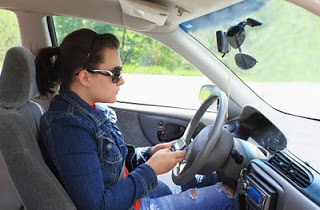
Reaching for Items in Your Vehicle and Distracted Driving
October 26, 2009
The hazard drivers create when they text or talk on cell phones has received considerable attention in the popular press recently. However, a more common distracted driving hazard is reaching for an item in the vehicle. Though cell phone use while driving is a significant problem, National Highway Traffic Safety Administration (NHTSA) studies indicate that it is a relatively small proportion of the distracted driving issue.
Driving distractions occur anytime something takes your eyes off the road, your hands off the steering wheel, or your mental attention from the task. Some distractions involve two or even all three of these. When you look for a particular song on a CD or MP3 player, your eyes turn from the road ahead, you remove at least one hand from the steering wheel, and you are temporarily preoccupied by the task of searching for the song you want to hear.
Other “reaching” distractions include:
- Eating
- Smoking
- Manipulating the controls of the aforementioned stereo, an in-vehicle navigation system or the climate control system
- Reaching for a fallen object
NHTSA estimates that drivers participate in potentially distracting activities about 30% of the time their vehicles are moving. Distraction may result in:
- loss of vehicle control
- unintended speed changes
- leaving the lane of travel
- missed opportunities to respond to changes in the driving scene
Though a motor vehicle crash caused by a driver reaching for something in the vehicle is not easily proved unless the driver admits to it, most drivers are aware of having driven while distracted by reaching for something in the vehicle.
“Reaching for something” does not have to mean reaching for an inanimate object. When they reach out to soothe, protect or discipline their children and pets, drivers’ attention is removed from the driving scene. Driving requires all your concentration, and parents should teach their children this and reinforce the lesson when necessary. Children should be fastened into appropriate safety restraint systems. While distractions aren’t good for you as a driver, they are great for children as passengers; DVDs, books, games, and small toys can keep them occupied until you reach your destination. If your children need attention, find a safe place to pull off the roadway. Your furry friend can travel safely in a pet carrier or safety harness. Never let your pet ride in your lap or roam around the vehicle while you drive.
Other ways to manage distractions include adjusting all of the vehicle’s controls before you start to drive and during stops at traffic lights, asking passengers to assist you when you need to get something inside your vehicle, and taking breaks to eat, drink and smoke.
Learning how to manage the distraction of reaching for things in your vehicle is a daunting task because it occurs so frequently. But doing so will allow you to keep you, your passengers, and other road users safe when you’re behind the wheel.
